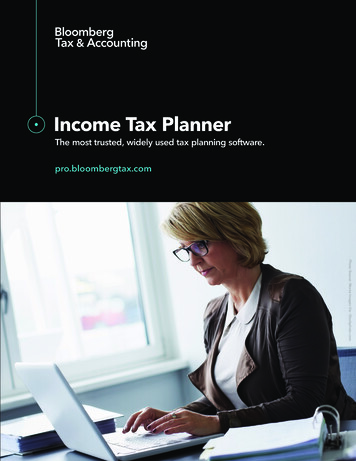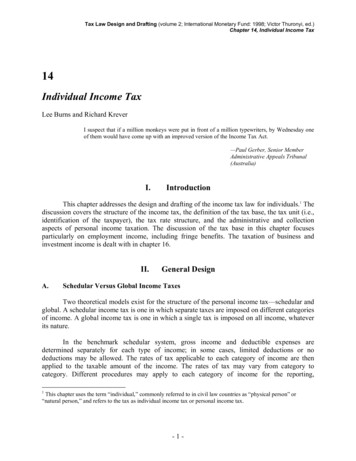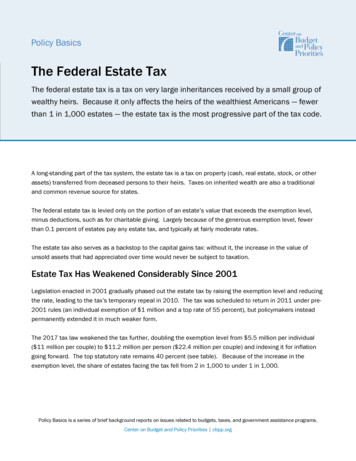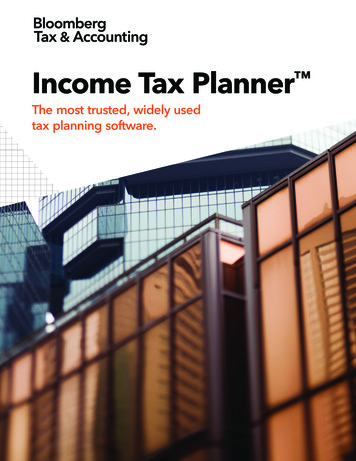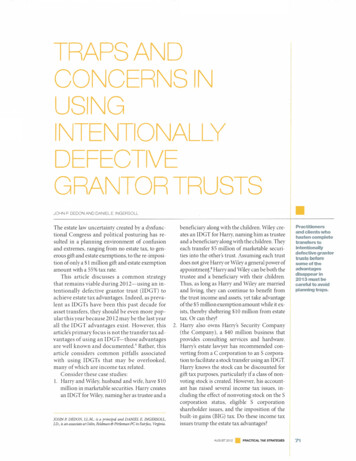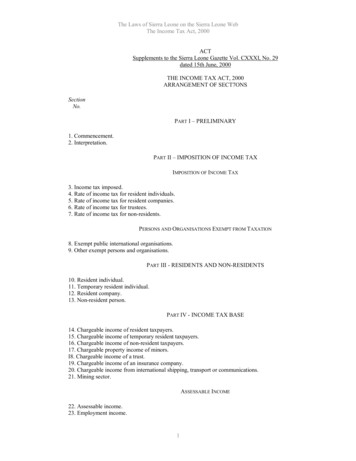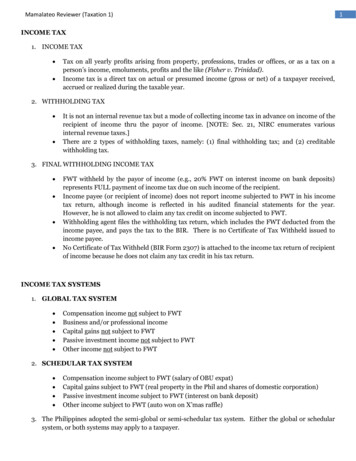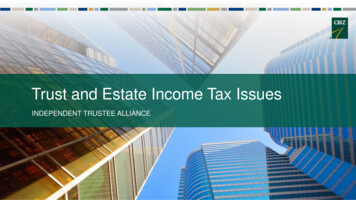
Transcription
Trust and Estate Income Tax IssuesINDEPENDENT TRUSTEE ALLIANCE
PresenterDan is the Senior Managing Director of the CBIZ & MHMColorado office and a member of the MHM Board of Directors.He is responsible for the overall management of the Coloradomarket, including financial performance, strategic planningefforts, and client satisfaction. A Certified Public Accountantand Certified Valuation Analyst, he has been providing tax,accounting and consulting services to middle-marketingcompanies and their owners for over 30 years.Dan SeffSenior Managing DirectorCBIZ Colorado720.200.7000 dseff@cbiz.comDenver Estate Planning CouncilCBIZ 2
About Us Together, CBIZ & MHM are a Top Ten accounting providerOffices in most major marketsTax, audit and attest and advisory servicesOver 5,000 professionals nationwideA member of Kreston InternationalA global network of independent accounting firmsMHM (Mayer Hoffman McCann P.C.) is an independent CPA firm that provides audit, review and attest services, and works closely with CBIZ, a business consulting, tax and financial services provider. CBIZ andMHM are members of Kreston International Limited, a global network of independent accounting firms.Denver Estate Planning CouncilCBIZ 3
DisclaimerThe information in this seminar is a brief summary and may notinclude all the details relevant to your situation.Please contact your service provider to furtherdiscuss the impact on your business.
Agenda Fundamental Concepts Essential to Fiduciary Income Tax Types of Trusts Income Tax Treatment of Distributions from Non-Grantor 5Trusts & EstatesDepreciation, Depletion and Amortization; Treatment andAllocation of DeductionsCharitable Income Tax Deduction Available to Estates andNon-Grantor TrustsApplication of Passive Activity Rules to Trusts & Estates
Agenda, cont’d. Income Tax Deductions for Administration Expenses Special Elections Available to Non-Grantor Trusts & 6EstatesTax Reporting Methods for Grantor TrustsNet Investment Income TaxState Return Filing FactorsRecent Developments
Status of Tax Legislation The Infrastructure Investment and Jobs Act (IIJA) was signed into lawNovember 15, 2021 This is the bill that focuses on “hard infrastructure” initiatives such as roads,bridges, and airports The IIJA also contains a few tax provisions, such as: Ending the Employee Retention Credit early by making the fourthquarter of 2021 ineligible Imposing new information reporting requirements for cryptocurrencytransactions, beginning in 2023 and 2024 Congress is continuing negotiations over the Build Back Better Act(BBBA) Passed the House on November 19, currently with the Senate The following slides detail some of the major provisions within the BBBA,and compare them with previous plans and proposals7
Fundamentals of Income Taxation of Trusts and Estates
Fundamentals Essential to Fiduciary Income Tax – Taxable Income Similar to computation for an individual’s taxable income, with notableexceptions with respect to deductions. Key points: 9The income reportable by a trust or an estate is the same as that for an individual.Allowable deductions include: real estate taxes, state and local taxes, investment interest, charitable contributions, net operating losses, administration expenses (e.g., fiduciary commissions, and accounting and legalfees), and a distribution deduction for amounts paid to beneficiaries.Special rules, unique to trusts and estates, apply to: Depreciation, depletion and amortization deductions, and; Charitable deductions
Fundamentals Essential to Fiduciary Income Tax – Taxable Income,cont’d. Exemption (§642(b)): Complex trust: 100Simple trust: 300 (even if a complex trust due to principal distributions)Estate: 600Qualified disability trust: Individual’s personal exemption ( 4,400 for 2022). 37% income tax rate20% long-term capital gain / qualified dividend rate3.8% net investment income taxPotentially alternative minimum tax Once taxable income exceeds 13,450 (2022): Taxable Year (§644): Trust – must be calendar year-end Estate – may be fiscal year-end10
Fundamentals Essential to Fiduciary Income Tax –Distributable Net Income (“DNI”) DNI generally refers to taxable income (without taking into account the distribution deduction and the personalexemption) plus net tax-exempt income; it typically does notinclude capital gains and losses (§643(a)).Determines how much of a distribution is deductible by a trustor an estate, and is taxable to the beneficiary who receivesthe distribution. Generally: Distributions up to and not exceeding DNI are deductible by thetrust or estate, and are taxable to the beneficiary. Distributions that exceed DNI are not deductible by a trust or anestate and not taxable to the beneficiary.11
Fundamentals Essential to Fiduciary Income Tax Fiduciary Accounting Income (“FAI”) FAI refers to the “income” of a trust or an estate as defined 12under state law or the governing instrument (§643(b); Reg. §1.643(b)-1).Generally includes interest and dividends and cashdistributions from partnerships and S corporations (that arenot liquidating distributions or distributions in redemption ofa holder’s interest), whether or not these items are taxable.These income items are then reduced by any allocableexpenses.Generally, capital gains/losses are considered principal (notincome) items and are therefore not included in this definition,subject to the terms of the governing instrument.
Fundamentals Essential to Fiduciary Income Tax Taxable income, DNI and FAI chiefly differ as describedbelow:Capital Gains/LossesTax Exempt IncomeTIXDNI FAIXCash Distributions fromPartnerships / S corps13K-1 Income fromPartnerships / S corpsXXXX
Types of Trusts
Types of Trusts – Simple Trust Requirements (Reg. §1.651(a)-1): All of the trust's income must be distributed currently (i.e., at least annually),No other amounts are distributed during the year, andThe trust does not provide for any amounts to be paid or permanently set aside forcharity. "Income" Required to be Distributed (IRC §643(b); Reg. §1.643(b)-1): FAI as determined under applicable local law and the trust agreementNot DNI or taxable income DNI passes out to the beneficiaries up to the amount of FAI.To the extent DNI exceeds FAI, the DNI will not pass out to the beneficiaries and willbe taxable to the trust.Any income required to be distributed during the year, but that is not distributed, isdeemed distributed on the last day of the tax year (IRC §652(a), Reg. §1.652(a)-1). Income Tax Treatment: 16
Misconception About Simple Trust A simple trust is only ever taxable on capital gains 17because all DNI passes out to the beneficiariesFALSE – FAI is the income that must be distributed, notDNI, and these are not necessarily the sameWhy? FAI includes partnership/S corporation cashdistributions while DNI includes K-1 income
Types of Trusts – Complex Trust Definition (Reg.§1.661(a)-1): All other trusts (other than a grantor-type trust) that do not meet the requirements of asimple trust (e.g., income is not required to be distributed currently and/or principaldistributions are made during the year). A simple trust that makes a principal distribution during the year is a complextrust for that year Trust still entitled to a 300 exemption. Generally taxed on all of its income unless it makes distributions. Income Tax Treatment: If a complex trust (or an estate) is required to distribute income currently, DNI isallocated (IRC §662(b); Regs. §1.662(a)(2) and §1.662(a)(3)):1.2.18To the beneficiaries who are entitled to the income (“tier one” beneficiaries),regardless of whether the distribution is actually madeAny remaining DNI is allocable among the other beneficiaries (“tier two”)beneficiaries, who received discretionary distributions.
Types of Trusts – Grantor Trust Characteristics: The grantor (or persons related to him/her) has certain rightsand powers which cause the trust to be deemed owned by thegrantor for income tax purposes (See IRC §§671-679). One of the most popular grantor trust provisions empowers thegrantor, in a non-fiduciary capacity, to reacquire the trustproperty by substituting other property of equivalent value (IRC§675(4)(C)). Income Tax Treatment: All the trust's income, losses, deductions and credits arereported by the grantor, rather than the trust (IRC §671). The trust may not even be required to file an income tax return(Reg. §1.671-4).19
Comment About Trust ClassificationThe tax character of a trust can change from year to year.Thus, the trust agreement and circumstances should bereviewed annually to determine if there have been anychanges which would affect the income tax treatment ofthe trust (e.g., grantor's death, change of trustee, etc.).20
Income Tax Treatment of Distributionsfrom Non-Grantor Trusts & Estates
General Rule Distributions are deductible to the trust and taxable to the recipients (on aproportionate basis) to the extent of DNI. (IRC §651 and §652(a); IRC §661(a) and §662(a)) The income tax character of the distribution to the beneficiary depends on theitems of income included in DNI, and is the same as it would be if these itemswere taxable to the trust. (IRC §652(b) and §662(b))1.2.23A pro rata share of each class of income included in DNI reduced by an allocableshare of the deductions is treated as passing out to the beneficiary. Expenses thatare not directly allocable to any income class (e.g., trustee commissions, stateincome tax) can be deducted against any income class included in DNI (after anallocation is made to tax-exempt income). (Reg. §1.652(b)-3)It is advisable to allocate indirect expenses to the income included in DNI that willbe taxed at the highest rate in the hands of the beneficiary. Typically, this meansnot allocating deductions to qualified dividends to the extent there is other income. If the beneficiary is a nonresident alien, it may be preferable to allocate indirectexpenses to qualified dividends subject to U.S. income tax rather than otherincome, such as U.S. bank interest, which is typically not subject to U.S. incometax when paid to a nonresident alien.
Distributions of In-Kind Property The amount of the distribution is the lesser of(IRC §643(e)(1) & (2)): the property’s adjusted basis in the hands of the trust(adjusted for any gain or loss recognized on thedistribution), or its fair market value. Such a distribution still carries out DNI to the beneficiary, 24even though the beneficiary is not receiving cash.Distribution of in-kind property generally is notconsidered a sale or exchange that triggers a gain orloss.
Special Rules Applicable to Pecuniary Distributions Deemed Sale or Exchange Treatment When a trust satisfies a beneficiary's right to a pecuniary amount (i.e., a fixed dollaramount that can also be stated as a formula) with in-kind property, there is a deemedsale or exchange of the property, and the trust realizes gain or loss. (Reg. §1.661(a)(2)(f))A deemed sale or exchange triggering gain or loss also occurs when a specificbequest of property is satisfied with other property or a beneficiary's right to income issatisfied with property in-kind. Related party rules bar a trust from deducting the loss incurred when it satisfies apecuniary amount with depreciated property, but an estate can deduct such a losswhen it satisfies a pecuniary bequest. (IRC §267(b)(13)) Beware: When a pecuniary bequest is satisfied with a right to income in respectof a decedent ("IRD"), the IRD becomes taxable to the estate even if the IRDhas not yet been received. Examples of common IRD items that would triggerincome recognition if used to satisfy a pecuniary bequest include installmentnotes, stock options and retirement plans.25
Separate Share Rule DNI generally passes out to the beneficiaries on a proportionate basiswhen they receive a distribution. However, if a trust has separateshares, this will not be the case. Rule: If a trust has more than one beneficiary, and those beneficiarieshave substantially separate and independent shares, those shares aretreated as separate trusts for purposes of determining:a) how much DNI is allocable to the respective beneficiary, andb) the appropriate distribution deduction of the trust or estate. (IRC §663(c);Reg. §1.663(c)-1) Separate Share In the Case of Trusts: The rule generally applies whentrust distributions are required to be made in substantially the samemanner as if separate trusts had been created. (Reg. §1.663(c)-3(a)) 26Example: Under the terms of a trust, the assets are divided into separateshares (but not separate trusts) for each of the grantor’s children, andthe trustee has discretion to distribute income and principal to thechildren from their respective share.
Separate Share Rule Separate Share in the Case of Estates: Applies when the governing instrument andapplicable local law create separate economic interests in one beneficiary or a classof beneficiaries. (Reg. §1.663(c)-4(a)) A separate share ordinarily exists if the economicinterests of one beneficiary or a class of beneficiaries neither affect nor are affectedby the economic interests accruing to another beneficiary or class of beneficiaries. Examples include:1.2.3. 27income on bequeathed property if the recipient of the bequest is entitled to suchincome,a surviving spouse’s elective share that under local law is entitled to income andshares in appreciation (and depreciation), anda qualified trust for which a §645 election was made to treat it as part of adecedent’s estate.The DNI allocable to any share is computed as if each share was a separate trust oran estate. (Reg. §1.663(c)-2(b)) Once the DNI allocable to a separate share is determined,that creates the ceiling for how much will be taxable to the beneficiary (and deductibleby the trust or estate) with respect to distributions to that beneficiary.The separate share rule is mandatory, not elective. Reg. §1.663(c)-1(d))
Separate Share Rule, cont’d. Comment: The separate share rule prevents a beneficiary from beingtaxed on a disproportionate share of trust or estate income when adistribution is made to him. Example: A decedent’s two children are each entitled to 50% of his 10 millionestate Child A receives his half of the estate in Year 1 Child B receives his half of the estate in Year 2 Without the separate share rule, assuming the estate has 50,000 ofDNI in Year 1, all of that DNI would be taxed to Child A, even thoughChild A is only entitled to 50% of the estate and its income. The effectwould be that Child A is taxed on Child B’s income. The separate share rule ensures that only 25,000 of the estate’s DNIis taxed to Child A, with the rest taxed to the estate, thereby reducingChild B’s share.28
Depreciation, Depletion and AmortizationTreatment and Allocation of Deductions
General Rules Estate: Depreciation, depletion and amortization (“DD&A”) are allocatedbetween an estate and its beneficiaries on the basis of how much of the estate'sFAI is allocable to each. (IRC §167(d), §611(b)(4), and §642(e). See also Reg. §1.167(h)-1(c) and §1.611-1(c)(5)) Trust: DD&A are allocated between a trust and its beneficiaries on thebasis of how much of the trust's FAI is allocable to each, unless the governinginstrument (or state law) requires or permits a trustee to maintain a reserve. (IRC§167(d), §611(b)(3), and §642(e). See also Reg. §1.167(h)-1(b) and §1.611-1(c)(4)) If all FAI is distributed to its beneficiaries, all of the DD&A passes out to thebeneficiaries even if it is more than the FAI. Even if a simple trust does not have any FAI, all of the DD&A passes out to thebeneficiaries. (Rev. Rul. 74-530) Typically, DD&A are not reported as separate items on a partnership K-1. Evenso, it appears that if an estate or a trust is a partner, its share of thepartnership's DD&A still must be allocated between the estate or trust and itsbeneficiaries. (Rev. Rul. 74-71)31
Charitable Income Tax Deduction Available to Estatesand Non-grantor Trusts
General Rule Estates and non-grantor trusts are allowed an unlimited charitableincome tax deduction for any gross income paid to charity pursuantto the terms of the governing instrument. (IRC §642(c)(1); Reg. §1.642(c)-1(a)(1)) Any charitable contributions made from principal or tax-exemptincome are not deductible. (Reg. §1.642(c)-3(b)) An estate, unlike a trust, is also allowed a charitable deduction forany income set aside for later distribution to charity pursuant to theterms of the governing instrument. (IRC §642(c)(2); Reg. §1.642(c)-2(a)) Example: If a trustee makes a charitable contribution of appreciatedproperty, the trust won't be entitled to a charitable deductionbecause the distribution is made from trust principal. Even if thetrustee makes the charitable contribution from trust income, it won'tbe deductible unless the trust agreement permits it.33
Application of Passive Activity Rules to Trusts & Estates
Lack of Clarity Currently, there aren't any regulations under IRC §469 that 35address when a trust or an estate is deemed to materiallyparticipate in an activity for purposes of the passive activityrules. (See Reg. §1.469-5T(g))According to the Committee Reports for the 1986 Tax ReformAct, a trust or an estate is deemed to materially participate inan activity if its executor or trustee, in its fiduciary capacity,materially participates in that activity. (S. Rept. No. 99-313 (Pub. Law 99-514) p. 735)Only current guidance are a couple of court cases and a fewrulings.
The Mattie K. Carter Trust v. U.S., 2003-1 USTC 50,418 Carter involved a trust that operated a working ranch. The trust hired a number of 36employees, including someone to manage the day-to-day operations of the ranch andmake all the important managerial and operational decisions, subject to the trustee'sapproval. Although the trust deducted the losses generated by the ranching activity, theIRS disallowed them, asserting that they were passive activity losses.The Service argued that the material participation of a trust in a trade or business forpurposes of IRC §469 should be determined by evaluating only the activities of the trustee,and in this case, those activities did not rise to the level of material participation. Thetaxpayer argued, and the District Court agreed, that because the trust (and not the trustee)is the taxpayer, material participation should be determined by assessing the activities ofthe trust. Furthermore, since a trust can only participate in an activity through itsfiduciaries, employees and agents, their activities as a whole should be considered indetermining the trust's level of participation. Applying this standard, the District Court heldthat the trust's activities rose to the level of material participation. Furthermore, the Courtconcluded that the trustee's activities alone with respect to the ranching operations weresuch that even under the IRS standard, the trust materially participated in the ranchingactivities.
TAM 200733023 A trust owned an interest in a limited liability company that engaged in an active trade or 37business. The trust had special trustees in addition to regular trustees. The issue waswhether the losses generated by the limited liability company were passive activity losses.The Service held that a trust is treated as materially participating in an activity if its trustee,in its fiduciary capacity, so participates. Furthermore, the Service concluded that theactivities of the special trustees should not be taken into account in determining whetherthe trust materially participated in the activity of the limited liability company. Even thoughthe special trustees were heavily involved in the operational and management decisions ofthe business, they could not do anything without the regular trustees' consent. Thus, theywere not fiduciaries of the trust and their activities did not count in determining whether thetrust materially participated in the business. As to the regular trustees, their activities didnot rise to the level of material participation.PLR 201029014 confirmed the IRS position taken in TAM 200733023 by concluding that atrust materially participates in a business activity only if its trustee materially participates.
TAM 201317010 The IRS once again took the position that whether a trust materially participates in an 38activity depends upon the level of activity of its trustees in their fiduciary capacity. TheService concluded that because the trusts in this TAM did not materially participate in theactivities of its S corporation, they would have to amortize their share of the S corporation’sresearch and development expenses over ten years for AMT purposes.Two identical trusts owned stock in an S corporation. The trusts had a regular trustee and aspecial trustee. The special trustee, who was one of the trust beneficiaries, was also thepresident of the company’s subsidiary and a shareholder. As special trustee, he controlledall decisions regarding the disposition of the company stock and voting of such stock, butdid not have any control over the company’s management or operations. Nevertheless, asthe subsidiary’s president, the special trustee was involved in the subsidiary’s day to dayoperations.The IRS took the position that only the special trustee’s activities in his fiduciary capacityshould be considered in determining the trust’s material participation. Thus, it refused tocount the work performed by the special trustee as the subsidiary’s president, andconcluded the activities, as special trustee, did not rise to the level of material participation.In addition, the regular trustee did not participate in the company’s day to day operationsso his activities, as well, did not rise to the level of material participation.
Frank Aragona Trust v. Commissioner, 142 T.C. No. 9(2014) The Tax Court held that a trust can qualify as a real estate professional and, assuch, materially participate in rental real estate activities. This is significantbecause any rental activity is considered per se passive unless the ownerqualifies as a real estate professional under IRC §469(c)(7). To qualify as a realestate professional, the taxpayer must perform more than one-half of hispersonal services (and more than 750 hours) in real property trades orbusinesses in which he materially participates. The IRS asserted that a trust could not qualify as a real estate professionalbecause a trust cannot render “personal services,” as required by the statute,because it is not an individual (the regulations define such services as any workperformed by an individual). The Court disagreed and held that if the trusteesare individuals, their work can be considered personal services rendered by anindividual, whereby the trust will satisfy the requirements of a real estateprofessional.39
Frank Aragona Trust v. Commissioner, 142 T.C. No. 9(2014), cont’d. Next, the Court considered whether the Aragona Trust qualified as a real estate 40professional. The Aragona Trust owned rental real properties directly and also throughentities, some of which were wholly owned and others through entities in which it ownedmajority interests. The trust had six trustees: the grantor’s five children and an independenttrustee. The trustees acted as a management board for the trust and made all majordecisions regarding the trust property. Three of the trustees worked full time for the whollyowned limited liability company that managed most of the trust’s rental real estateproperties. Two of these same trustees also owned minority interests in some of the othertrust-owned real estate entities. The other three trustees were involved in the trust’sactivities on a limited basis.Based upon the different roles of the trustees – namely, as fiduciaries, as employees of thewholly owned real estate management company, and as co-owners of some of the realestate entities – the Court held that the trustees materially participated in the trust’s realestate activities. Counting the trustees’ activities in other capacities is notable since itseems contrary to the ruling in TAM 201317010. Considering that only three of the sixtrustees were involved in the trust’s day-to-day activities, this could mean that a trust canbe deemed to materially participate in an activity even if fewer than a majority of itstrustees participate.
Special Rule for Grantor Trusts In the case of a grantor trust, material participation isdetermined by the activities of the grantor or beneficiaryto the extent either is treated as the owner of the trust forincome tax purposes. (50 S. Rept. No. 99-313 (Pub. Law 99-514) p. 735; General Explanation of the TaxReform Act of 1986 (Pub. Law 99-514) p. 242; See also Temp. Reg. §1.469-1T(b)(2) and FSA 200035006) Similarly, in the case of a Qualified Subchapter S Trustthat is treated as a grantor trust with respect to the solebeneficiary, material participation is determined by theactivities of the beneficiary. (General Explanation of Tax Reform Act of 1986 (Pub. Law 99-514) p.242)41
Income Tax Deductions for Administration Expenses
General Rules Administration expenses incurred by an estate or trust typically include: legal fees,trust accounting fees required by the trust agreement,trust tax return preparer fees,investment advisory fees,appraisal fees,selling expenses & commissions,management services, andfees paid to a trustee or executor. To be fully deductible (without the 2% limitation) in arriving at adjusted gross income,administration expenses must meet two requirements under IRC. § 67(e): the cost must be paid or incurred in connection with the administration of the estate or trust;andthe cost would not have been incurred if the property were not held in such trust or estate. If an expense does not meet these requirements it is not deductible as a miscellaneousitemized deduction as miscellaneous itemized deductions were suspended by the 2017Tax Act.44
General Rules, cont’d. Estate administration expenses are deductible only to 45the extent they are not deducted on the estate tax return(Form 706).Expenditures incurred for the benefit of the beneficiariesor heirs, rather than being essential to the settlement ofthe estate or the purpose of the trust, are not deductible.
General Rules – Grantor Trusts Items of income and expense pass through to the 46grantor, and the trust is disregarded as a separate entity.Administration expenses for a grantor trust are attributedto the grantor/owner and will be treated as expensessubject to the 2% of AGI limitation at the grantor/ownerlevel and thus not deductible under the 2017 Tax Act.
No Double Deduction for Administration Expenses Estate administration expenses and casualty and theft 47losses allowed as estate tax deductions under IRC. §2053(a)(2) and 2054 cannot be claimed as deduction onboth the Form 706 and Form 1041 [ IRC § 642(g)].Without a special election, estate administrationexpenses are deductible on Form 706.The executor or administrator may elect to claim thededuction (or a portion thereof) against gross income onForm 1041 (§642(g) election).
Attorney, Accountant, and Return Preparer Fees Expenses paid by an estate or trust for work performed by anattorney, accountant, or tax return preparer are deductiblewithout regard to the 2% of AGI limitation when suchexpenses would not be incurred if the property were heldoutside the trust. (IRC § 67(e); Reg. 1.212-1(I)) Regulations specifically include the preparation of fiduciaryincome tax and estate tax returns as an example of an expenseconsidered to be unique (and thus, fully deductible). For an estate, these fees are administration expenses.Without a special election, estate administration expenses aredeductible on Form 706.48
Allocations to Tax Exempt Income When a trust or estate has tax-exempt income, areasonable allocation of administration expenses notdirectly attributable to any certain class of income mustbe made to the tax-exempt income (and is therefore notdeductible). (Reg. 1.265-1(c))49
Deducting Investment Advisory Fees When the 2% Limitation Applies Investment advisory fees incurred in administering the estate ortrust are generally treated as miscellaneous itemized deductionsreduced by 2% of AGI and thus not deductible under the 2017 TaxAct. If such fees would not have been commonly incurred if the propertyhad been held outside the estate or trust, the 2% floor limitationdoes not apply. (IRC. §67(e)(1)) Unfortunately, this test is not easy to qualify and quantify because itrequires that an expense would not be commonly incurred if theproperty had not been held in trust or by an estate. If an expense would be incurred regardless of whether the propertyis held in trust or by an estate, if fails the “not commonly incurred”test and is subject to the 2% AGI limitation and is not deductible.50
Deducting Investment Advisory Fees, cont’d. In January 2008, the Supreme Court ruled in Knight v. Com’r, 2008-1 51USTC ¶50,132 that §67(e)(1) provides an exception from the 2%limitation only for costs that would be uncommon (or unusual, orunlikely) for a trust to incur if the property was held by an individual,rather than by a trust.In response, IRS issued proposed regulations in 2011 that wouldrequire estates and non grantor trusts to be subject to the 2% limit if thecost was a miscellaneous itemized deduction under §67(b) that wouldbe “commonly” or “customarily” incurred by a hypothetical individualholding the same property.Final regulations issued in May of 2014 largely followed therequirements in the proposed regulations (i.e., that miscellaneousitemized deductions incurred by an estate or trust are subject to the 2%floor if commonly or customarily incurred by a hypothetical i
About Us Together, CBIZ & MHM are a Top Ten accounting provider Offices in most major markets Tax, audit and attest and advisory services Over 5,000 professionals nationwide A member of Kreston International A global network of independent accounting firms MHM (Mayer Hoffman McCann P.C.) is an independent CPA firm that provides audit, review and attest services, and works closely with CBIZ, a .


